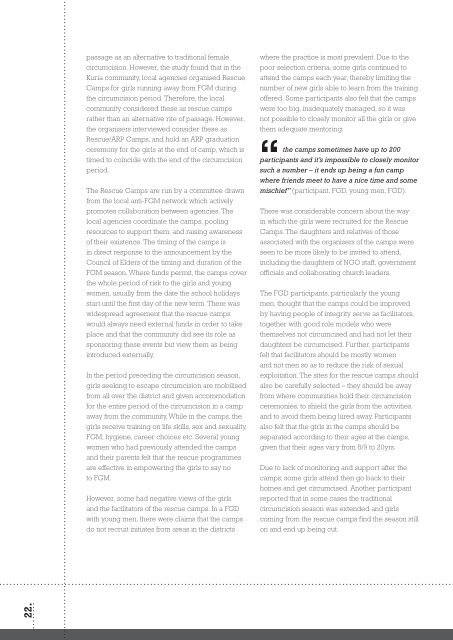Female Genital Mutilation practices in Kenya: - Feed the Minds
Female Genital Mutilation practices in Kenya: - Feed the Minds
Female Genital Mutilation practices in Kenya: - Feed the Minds
Create successful ePaper yourself
Turn your PDF publications into a flip-book with our unique Google optimized e-Paper software.
22.<br />
passage as an alternative to traditional female<br />
circumcision. However, <strong>the</strong> study found that <strong>in</strong> <strong>the</strong><br />
Kuria community, local agencies organised Rescue<br />
Camps for girls runn<strong>in</strong>g away from FGM dur<strong>in</strong>g<br />
<strong>the</strong> circumcision period. Therefore, <strong>the</strong> local<br />
community considered <strong>the</strong>se as rescue camps<br />
ra<strong>the</strong>r than an alternative rite of passage. However,<br />
<strong>the</strong> organisers <strong>in</strong>terviewed consider <strong>the</strong>se as<br />
Rescue/ARP Camps, and hold an ARP graduation<br />
ceremony for <strong>the</strong> girls at <strong>the</strong> end of camp, which is<br />
timed to co<strong>in</strong>cide with <strong>the</strong> end of <strong>the</strong> circumcision<br />
period.<br />
The Rescue Camps are run by a committee drawn<br />
from <strong>the</strong> local anti-FGM network which actively<br />
promotes collaboration between agencies. The<br />
local agencies coord<strong>in</strong>ate <strong>the</strong> camps, pool<strong>in</strong>g<br />
resources to support <strong>the</strong>m, and rais<strong>in</strong>g awareness<br />
of <strong>the</strong>ir existence. The tim<strong>in</strong>g of <strong>the</strong> camps is<br />
<strong>in</strong> direct response to <strong>the</strong> announcement by <strong>the</strong><br />
Council of Elders of <strong>the</strong> tim<strong>in</strong>g and duration of <strong>the</strong><br />
FGM season. Where funds permit, <strong>the</strong> camps cover<br />
<strong>the</strong> whole period of risk to <strong>the</strong> girls and young<br />
women, usually from <strong>the</strong> date <strong>the</strong> school holidays<br />
start until <strong>the</strong> first day of <strong>the</strong> new term. There was<br />
widespread agreement that <strong>the</strong> rescue camps<br />
would always need external funds <strong>in</strong> order to take<br />
place and that <strong>the</strong> community did see its role as<br />
sponsor<strong>in</strong>g <strong>the</strong>se events but view <strong>the</strong>m as be<strong>in</strong>g<br />
<strong>in</strong>troduced externally.<br />
In <strong>the</strong> period preced<strong>in</strong>g <strong>the</strong> circumcision season,<br />
girls seek<strong>in</strong>g to escape circumcision are mobilised<br />
from all over <strong>the</strong> district and given accommodation<br />
for <strong>the</strong> entire period of <strong>the</strong> circumcision <strong>in</strong> a camp<br />
away from <strong>the</strong> community. While <strong>in</strong> <strong>the</strong> camps, <strong>the</strong><br />
girls receive tra<strong>in</strong><strong>in</strong>g on life skills, sex and sexuality,<br />
FGM, hygiene, career choices etc. Several young<br />
women who had previously attended <strong>the</strong> camps<br />
and <strong>the</strong>ir parents felt that <strong>the</strong> rescue programmes<br />
are effective <strong>in</strong> empower<strong>in</strong>g <strong>the</strong> girls to say no<br />
to FGM.<br />
However, some had negative views of <strong>the</strong> girls<br />
and <strong>the</strong> facilitators of <strong>the</strong> rescue camps. In a FGD<br />
with young men, <strong>the</strong>re were claims that <strong>the</strong> camps<br />
do not recruit <strong>in</strong>itiates from areas <strong>in</strong> <strong>the</strong> districts<br />
where <strong>the</strong> practice is most prevalent. Due to <strong>the</strong><br />
poor selection criteria, some girls cont<strong>in</strong>ued to<br />
attend <strong>the</strong> camps each year, <strong>the</strong>reby limit<strong>in</strong>g <strong>the</strong><br />
number of new girls able to learn from <strong>the</strong> tra<strong>in</strong><strong>in</strong>g<br />
offered. Some participants also felt that <strong>the</strong> camps<br />
were too big, <strong>in</strong>adequately managed, so it was<br />
not possible to closely monitor all <strong>the</strong> girls or give<br />
<strong>the</strong>m adequate mentor<strong>in</strong>g:<br />
<strong>the</strong> camps sometimes have up to 200<br />
participants and it’s impossible to closely monitor<br />
such a number – it ends up be<strong>in</strong>g a fun camp<br />
where friends meet to have a nice time and some<br />
mischief” (participant, FGD, young men, FGD).<br />
There was considerable concern about <strong>the</strong> way<br />
<strong>in</strong> which <strong>the</strong> girls were recruited for <strong>the</strong> Rescue<br />
Camps. The daughters and relatives of those<br />
associated with <strong>the</strong> organisers of <strong>the</strong> camps were<br />
seen to be more likely to be <strong>in</strong>vited to attend,<br />
<strong>in</strong>clud<strong>in</strong>g <strong>the</strong> daughters of NGO staff, government<br />
officials and collaborat<strong>in</strong>g church leaders.<br />
The FGD participants, particularly <strong>the</strong> young<br />
men, thought that <strong>the</strong> camps could be improved<br />
by hav<strong>in</strong>g people of <strong>in</strong>tegrity serve as facilitators,<br />
toge<strong>the</strong>r with good role models who were<br />
<strong>the</strong>mselves not circumcised and had not let <strong>the</strong>ir<br />
daughters be circumcised. Fur<strong>the</strong>r, participants<br />
felt that facilitators should be mostly women<br />
and not men so as to reduce <strong>the</strong> risk of sexual<br />
exploitation. The sites for <strong>the</strong> rescue camps should<br />
also be carefully selected – <strong>the</strong>y should be away<br />
from where communities hold <strong>the</strong>ir circumcision<br />
ceremonies, to shield <strong>the</strong> girls from <strong>the</strong> activities,<br />
and to avoid <strong>the</strong>m be<strong>in</strong>g lured away. Participants<br />
also felt that <strong>the</strong> girls <strong>in</strong> <strong>the</strong> camps should be<br />
separated accord<strong>in</strong>g to <strong>the</strong>ir ages at <strong>the</strong> camps,<br />
given that <strong>the</strong>ir ages vary from 8/9 to 20yrs.<br />
Due to lack of monitor<strong>in</strong>g and support after <strong>the</strong><br />
camps, some girls attend <strong>the</strong>n go back to <strong>the</strong>ir<br />
homes and get circumcised. Ano<strong>the</strong>r participant<br />
reported that <strong>in</strong> some cases <strong>the</strong> traditional<br />
circumcision season was extended and girls<br />
com<strong>in</strong>g from <strong>the</strong> rescue camps f<strong>in</strong>d <strong>the</strong> season still<br />
on and end up be<strong>in</strong>g cut.




